The AMD Radeon RX 5700 XT & RX 5700 Review: Navi Renews Competition in the Midrange Market
by Ryan Smith on July 7, 2019 12:00 PM ESTPower, Temperatures, & Noise
Last, but not least of course, is our look at power, temperatures, and noise levels. While a high performing card is good in its own right, an excellent card can deliver great performance while also keeping power consumption and the resulting noise levels in check.
| Radeon Video Card Voltages | |||||
| 5700 XT Max | 5700 Max | 5700 XT Idle | 5700 Idle | ||
| 1.2v | 1.025v | 0.725v | 0.775v | ||
Looking at boost voltages for AMD's new midrange 7nm cards, we don't have too many points of comparison right now. But still, with AMD's drivers reporting a maximum boost voltage of 1.2v for the 5700 XT, not even the incredibly juiced Polaris 30-based Radeon RX 590 took quite so much voltage. It may very well be that TSMC's high-performance 7nm process simply requires a lot of voltage here, but it may also be a sign that AMD is riding the voltage/frequency curve pretty hard to get those high clockspeeds.
By contrast, the 5700 (vanilla) is a much more mundane card. With its lower clockspeeds, the card never goes above 1.025v according to AMD's drivers. Which given the impact of voltage on power consumption, it's actually a bit surprising the spread is so large.
| Radeon Video Card Average Clockspeeds (Rounded to the Nearest 10MHz) |
|||
| Game | 5700 XT | 5700 | |
| Max Boost Clock | 2044MHz | 1750MHz | |
| Official Game Clock | 1755MHz | 1625MHz | |
| Tomb Raider | 1780MHz | 1680MHz | |
| F1 2019 | 1800MHz | 1650MHz | |
| Assassin's Creed | 1900MHz | 1700MHz | |
| Metro Exodus | 1780MHz | 1640MHz | |
| Strange Brigade | 1780MHz | 1660MHz | |
| Total War: TK | 1830MHz | 1690MHz | |
| The Division 2 | 1760MHz | 1630MHz | |
| Grand Theft Auto V | 1910MHz | 1690MHz | |
| Forza Horizon 4 | 1870MHz | 1700MHz | |
Meanwhile clockspeeds are also an interesting story. AMD said that they would no longer be holding back their chips' top boost clocks, and instead let the silicon lottery run its course, allowing the best chips to reach their highest clockspeeds. The end result is that our 5700 XT is allowed to clock up to 2044 MHz, 139MHz better than AMD's official Boost Clock metric guarantees. More to the point, this is a substaintial jump in frequency over both AMD's RX Vega and RX 500 series cards, which would top out around the mid-1500s.
That said, the 5700 XT doesn't have the TDP or thermal cap to susntain this; I couldn't actually hit 2044MHz even in LuxMark, which as a "light" compute workload tends to bring out the highest clockspeeds in processors. Instead, the best clockspeed I was able to hit was a bit lower, at 2008MHz. So while the silicon is willing, the physics of powering a Navi 10 at such high clockspeeds are another matter.
At any rate, even with TDP and cooling keeping the 5700 XT more down to earth, the card is still able to hit high clockspeeds. More than half of the games in our benchmark suite average clockspeeds of 1800MHz or better, and a few get to 1900MHz. Even The Division 2, which appears to be the single most punishing game in this year's suite in terms of clockspeeds, holds the line at 1760MHz, right above AMD's official game clock.
As for the 5700, with its more conservative TDP, clockspeed specifications, and likely some binning, the card doesn't reach quite as high. Its 1750MHz max boost clock is just 25MHz over AMD's guaranteed clock. Meanwhile its clockspeeds are overall a bit more densely packed than the 5700 XT's; all of our games see average clockspeeds between 1630MHz and 1700MHz.
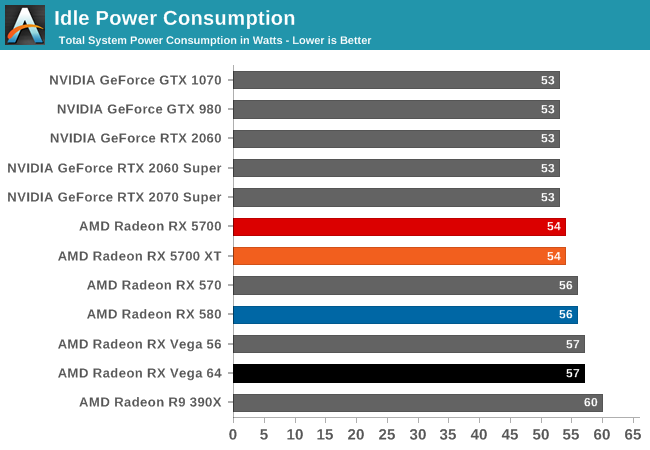
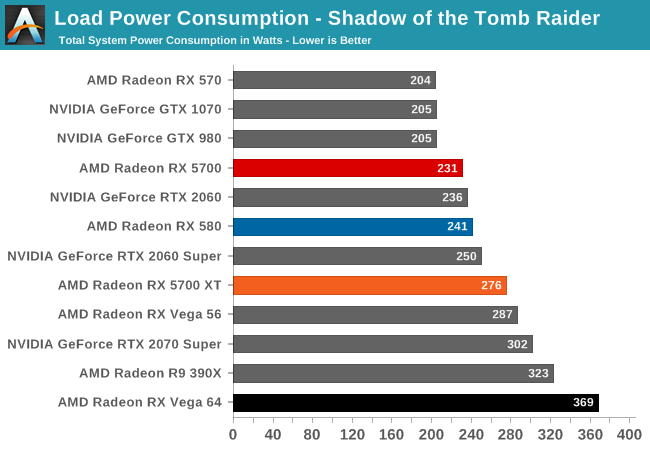
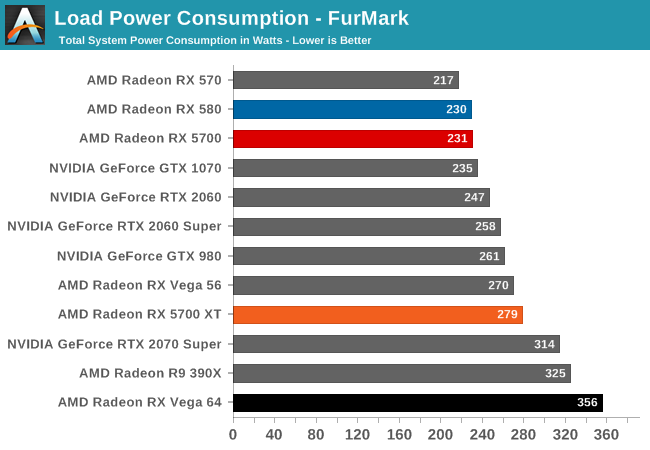


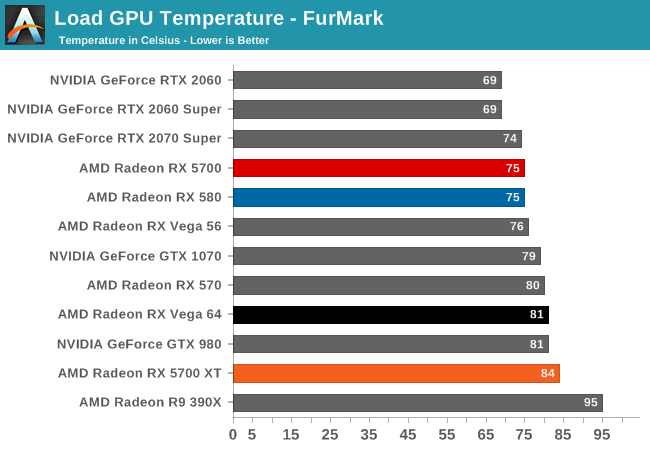
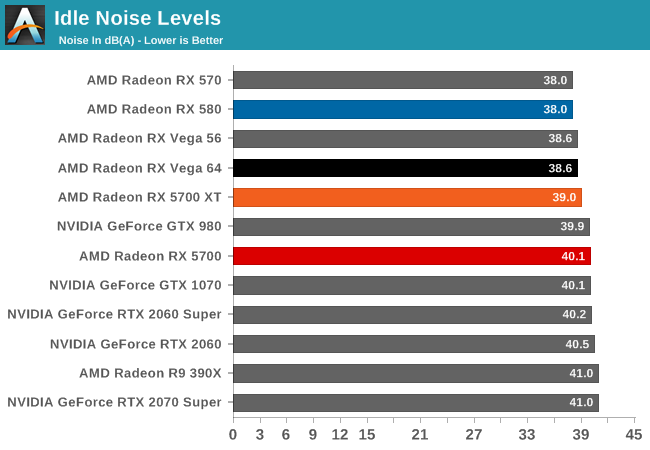
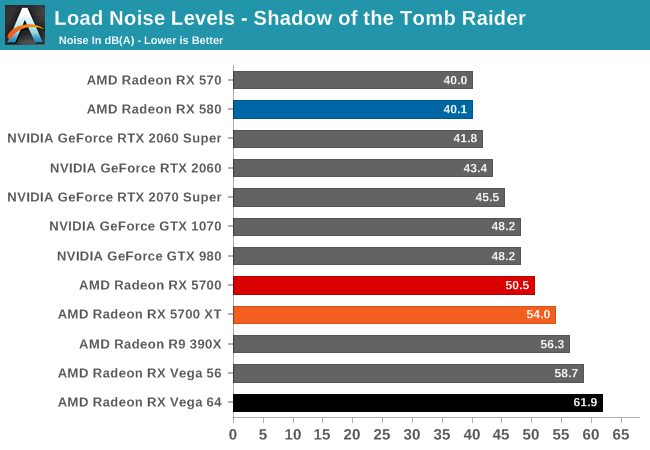
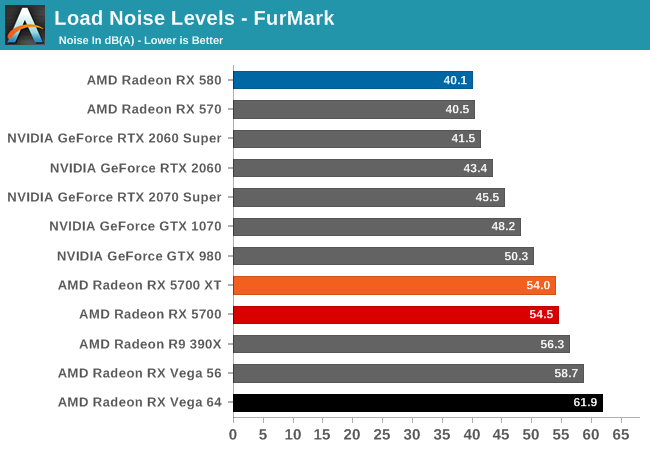










135 Comments
View All Comments
CiccioB - Wednesday, July 10, 2019 - link
The difference in gain is not 13%. dB are not linear but logarithmic.Each 3 dB means that the noise doubles, so 61.9 - 54.5 is a difference of 7.5db, meaning that the loudest measure is about 6 times more loud that the quieter one.
I don't know about the discrepancy in the measurements, but it is quite big to not need a deeper look by the reviewer reporting those numbers.
Silma - Thursday, July 11, 2019 - link
Too bad, I would have been interested in the RX 5700 XT but it's way too noisy.CiccioB - Friday, July 12, 2019 - link
Wait for the custom version. In a couple of months. Probably.tomc100 - Friday, July 12, 2019 - link
I'll probably wait for the water cooled version since this card is too hot and a fan will just make my room 80 degrees fahrenheit within 30 minutes. Sick of all the price gouging from Nvidia and the fact that they release a super before AMD's launch proves it. Despicable company.MDD1963 - Saturday, July 13, 2019 - link
Nice review; I think the 5700Xt stacks up against the 2060 Super and 2070 Super quite nicely.....; Hell, I'd hit it if I could! :)coolrock2008 - Saturday, July 13, 2019 - link
The cards were tested on an Intel CPU platform and i understand why. But, I was just wondering if the PCIe 4 switch brought any benefit at all to the cards? Any specific workload/benchmark that can benefit from the increased bandwidth? What are your thoughts on it @Ryan ?Mason1232 - Saturday, July 27, 2019 - link
Aimed at what these days is the midrange segment of the video card market, AMD is looking to carve out a new place for the companyballsystemlord - Saturday, July 27, 2019 - link
I love coffee, I love tea, I love Ryan's article on Navi! (Even though it's not finished yet...)viivo - Thursday, August 1, 2019 - link
The 5700s losing in all the Vulkan benchmarks is making me consider hitting that "cancel order" button and go with a 2060/70 Super. AMD should never perform worse in Vulkan against supposedly equally powered competition.cvearl - Tuesday, September 10, 2019 - link
I ahve the XFX 5700 non XT model. Refence cooler. It was less so noise that was the issue but more the revving of the fan. It was never sure on a speed to settle at. So I went into Wattman and locked the fanspeed to 30% (~1700 RPM) for anything above 50C across the board. Clocks hover between 1650 - 1700 MHz during long gaming sessions. Temp wise it settles in at about 85C and is a bit quieter than my old RX580 ASUS Rog Strix OC model. I wish they just shipped it like than rather than leave me to tweak it myself.